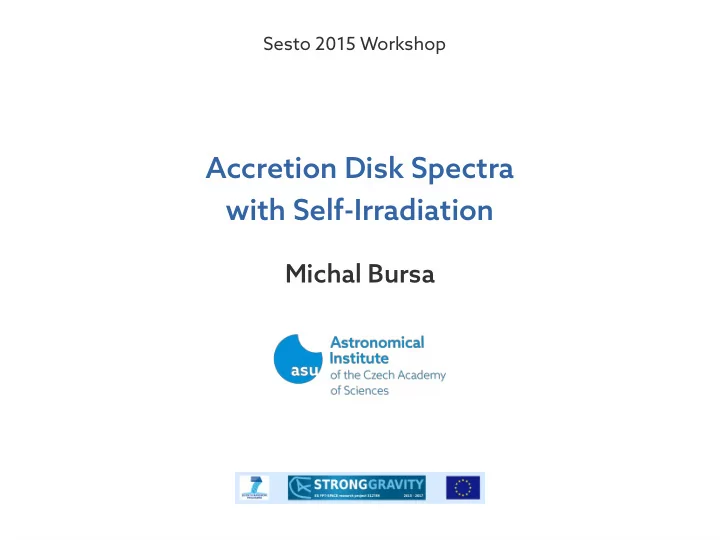

S e s t o 2 0 1 5 Wo r k s h o p A c c r e t i o n D i s k S p e c t r a w i t h S e l f - I r r a d i a t i o n Mi c h a l B u r s a
Motjvatjon ● radiatjon escapes accretjon disk in all directjons ● some photons reach observer, some are captured by the black hole, some hit the disk surface ( returning radiatjon, self-irradiatjon, back-radiatjon ) ● how much fmux comes back depends on disk shape and spacetjme → spin+Mdot functjon ● up to now only qualitatjve treatment (Li+2005) by adjustjng Mdot ● check Li's approach plus asses the efgect on spin estjmates
Motjvatjon ● radiatjon escapes accretjon disk in all directjons ● some photons reach observer, some are captured by the black hole, some hit the disk surface ( returning radiatjon, self-irradiatjon, back-radiatjon ) ● how much fmux comes back depends on disk shape and spacetjme → spin+Mdot functjon ● up to now only qualitatjve treatment (Li+2005) by adjustjng Mdot ● check Li's approach plus asses the efgect on spin estjmates
Objectjves WP10 tries to improve on: ● detailedness of the underlying physical models of thermal emission of stellar-mass black-hole accretjon disks ● accuracy of the modelling with respect to observatjonal evidence. trying to assess how much difgerence there is in assumptjons that existjng thermal emission models makes in comparison with newly developed or improved models in which some of those simplifying assumptjons are relaxed. Codes used: ● SIM5 (ASU) for ray-tracing ● TLUSTY (UoA) for radiatjve transfer + improvements ● C/Python/Bash bindings
Numerical Procedure (1) 1. set up disk radial structure ● disk model (thin/slim) ● BH spin, mass accretjon rate (luminosity), alpha ● divide disk into set of rings (by increments of F(r)*r*dr); ~150 rings ● each ring has: efg. temperature, column density, vertjcal gravity, spec. ang. momentum, radial velocity ● each ring is treated as infjnite plane-parallel layer (no communicatjon between rings => constrain on some parameters)
Numerical Procedure (1) 1. set up disk radial structure ● disk model (thin/slim) ● BH spin, mass accretjon rate (luminosity), alpha ● divide disk into set of rings (by increments of F(r)*r*dr); ~150 rings ● each ring has: temperature, column density, vertjcal gravity, spec. ang. momentum, radial velocity ● each ring is treated as infjnite plane-parallel layer (no communicatjon between rings => constrain on some parameters)
Numerical Procedure (2) 2. ring spectra with TLUSTY ● fjnd solutjon for vertjcal disk structure and radiatjon fjeld simultaneously ● initjal anzatz = grey atmosphere model ● result from anzatz is used for refjnement ● TLUSTY not always converges (problems with ion transitjons, optjcal depth, radiatjon pressure, low vertjcal gravity) => iteratjons from suitable anzatz (neighbouring ring) or isothermal atmosphere (low tau) or approximatjon (black body)
Numerical Procedure (2) 2. ring spectra with TLUSTY ● fjnd solutjon for vertjcal disk structure and radiatjon fjeld simultaneously ● initjal anzatz = grey atmosphere model ● result from anzatz is used for refjnement ● TLUSTY not always converges (problems with ion transitjons, optjcal depth, radiatjon pressure) => iteratjons from suitable anzatz (neighbouring ring) or isothermal atmosphere (low tau) or approximatjon (black body)
Numerical Procedure (3) 3. irradiatjon fjeld ● compute angularly resolved fjeld of returning radiatjon ● at each ring ray-trace over local observer's sky (half-sphere on top of disk photosphere) and collect photons that come from difgerent places at the disk surface (fully relatjvistjc, surface-to-surface)
Numerical Procedure (3)
Numerical Procedure (3) a=0.0, L=0.5 a=0.0, L=0.1
Numerical Procedure (4) 4. spectrum with external radiatjon ● run TLUSTY again and obtain new solutjon for vertjcal disk structure providing disk radiatjon fjeld from step 3 as an external radiatjon source on the top-most vertjcal zone ● even more problems with convergence because of the discontjnuity in the fjrst and second top-most zones → mostly solved by a 'dilutjon factor' that controls the fractjon of returning radiatjon considered (e.g. for a=0.98 and L=0.5 we have to aproximate 17 out of 157 rings) 5. iteratjons ● steps 3 and 4 should be repeated few tjmes because new solutjons from step 4 change the returning radiatjon fjeld a bit so we go back to step 3 and re-calculate it
Numerical Procedure (4)
Results Ring spectra ● for each setup (spin/luminosity) we have ~150 individual ring spectra ● spin from 0.0 to 0.99 ● luminosity from 0.1 to 0.5 (but not for all spins) ● higher spins converge less ofuen → can only use in combinatoin with low L Spectral table ● spectra for individual rings are ray-traced into a single 'observed' spectrum ● a FITS table is compiled from the fjnal spectra to be used as an XSPEC model parameters of the FITS table: - BH spin - disk luminosity (mass accretjon rate) - inclinatjon (BH mass and distance are included in normalizatjon)
Results a=0.0 L=0.1 1.0e-06 disk disk+irr NT-BB 1.0e-07 1.0e-08 0.1 1 10 1.0e-06 disk disk+irr NT-BB 1.0e-07 0.1 1 10
Results Applicatjons to data ● spectra are harder with returning radiatjon (additjonal contributjon, harder spectrum) → gives higher spin estjmates as functjon of L ● observatjons indicate the opposite: spectra are sofuer than modelled ● stjll, for L<0.3 the efgect on spin estjmates can be ~10%
Summary D10.1 ● numerical calculatjon of dozens of accretjon disk annuli spectra performed for each individual model setup ● limited only to low luminositjes (L<~0.5 L_Edd), higher L without TLUSTY D10.2 ● spectra for rings are ray-traced into a single 'observed' spectrum ● those are put into a FITS fjle table to be used in XSPEC ● model in on GitLab and will be published on project web page too
Recommend
More recommend